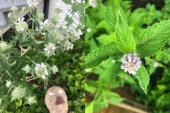I have lived in GA zone 7 for a few years now, what you have in your photos look like a lot of the same stuff that was on my land when we first moved in.
e. Looks like Japanese honeysuckle--invasive, aggressive groundcover--not too bad until it is allowed to strangle trees. I've found stout black walnuts nearly girdled to death by these vines so just be ware of that.
f. Is probably autumn olive/silverberry.
i. Is clearly some kind of low berry bush.
Our first big step in creating the food forest here was planting 250+ bare root seedlings, mostly from Tennessee Dept. of Agriculture:
East Tennessee Nursery. I drove to Delano, TN and picked them up in person to save on the shipping (it's not too far over the border). We did 100 persimmon, 100 locust, 25 hazelnut and 25 elderberry from them that first winter and it turned out to be a great deal--all growing well now two years on.
Another bulk nursery over in Chatsworth, GA is
Native Forest Nursery. They will ship or let you pick up the seedlings (bare root bundles or air-prune containers) and I've had good experiences there.
Many states around the country operate public seedling nurseries that will sell trees online for often very cheap. Look up "missouri seedlings" "virginia seedlings" "north carolina seedlings" etc. and you'll pull up the state nursery site pretty quick.
My other recommendation is to let the land grow wild for at least one winter (don't mow or bush hog) and see what kind of native trees come up. Oaks, burch and pine of course but on our land we were surprised to see dozens of mature persimmon and sourwood spring up from long dormant root systems.
The other vital thing to get started: Make or buy a cheap A-frame level and start laying out contour swales. Very important in the mountains and I can tell you it really saved my land, just installing a dozen long, shovel-deep swales... ON-CONTOUR!







